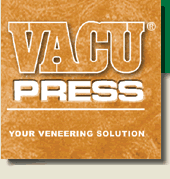Darryl Keil

Posts: 1455
Joined: 2003-05-22
Location: Maine
 User Profile User Profile |
Your questions gives me an opportunity to speak about this topic of the bleeder mesh, (we call it EvacuNet) and hopefully clear up certain misconceptions. Let me start here, the purpose of any mesh, grooved platen board, stick and even a piece of string, is to provide a pathway for the air to get down to the exit port and out of the bag, thats it. As long as the air get out of the bag, which method gets used doesnt matter, one is not better than another. The secondary issue is only which method gets the air out as fast as the pump wants to evacuate it. As single piece string over your panel to the exit nipple is going to take the pump longer to draw the air out than a grooved platen or bleeder mesh. But….this really only matters with a auto self cycling pump.
A grooved platen board is by far the most efficient air evacuation method as the grooves provide “little rivers” so to speak, that all converge at the exit hole. Where as bleeder mesh allows the air to “trickle” through it, which is fine, but for auto self cycling pumps the platen board is a better bet. Not to mention the platen board is better for sliding your panels in and out on top of, less wear and tear on the bag. If you just dont want to take the time to make a platen, bleeder mesh is surely easier and quicker to set up.
As far as a bleeder mesh type product providing more clamping power, that is simply nonsense. Once the air is fully out of the bag the pressure you get is simply whatever the pump is pulling. Also, having a caul between the bag and veneer is always a good idea. A rigid caul such as a piece of MDF, particle board, or plywood provide a hard leveling surface that prevents veneer from possibly wrinkling. The soft flexible nature of a bleeder mesh can allow veneer to be slightly wavy or wrinkle, and can also leave marks in the veneer. Also, for clarification, I call a platen board what goes under your panel that has grooves in it. What goes on top and provides this leveling pressure on the veneer I call a caul.
One more thing, if you use a grooved platen board the addition of a bleeder mesh is unnecessary. The platen board does the job just fine. No need to have both.
|





